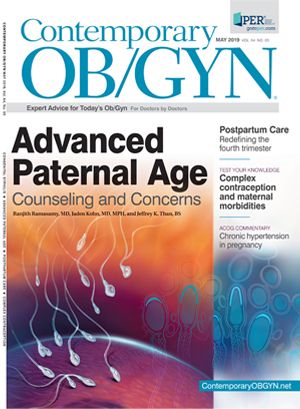Was this rectocele repair necessary?
Treatment should follow a conservative approach – especially when the patient is asymptomatic.

A 40-year-old G2P2002 was seen for her well-woman visit with complaints of heavy menstrual bleeding, “symptoms of a rectocele,” and her uterus falling lower and lower. No specific symptoms related to the rectocele were documented. There was right lower quadrant pain on the abdominal exam. The woman’s pelvic exam revealed first- to second-degree uterine prolapse, a first-degree cystocele, and a first-degree rectocele. Pelvic ultrasound identified a solid, right adnexal mass measuring 5 x 7 x 7 cm. The patient was scheduled for possible laparoscopy and/or laparotomy with total abdominal hysterectomy, right salpingo-oophorectomy, possible bladder repair, and possible posterior repair. She underwent a cystometry (CMG), due to complaints of occasional urine leakage during prior well-woman visits, and the results were normal.
The patient underwent total abdominal hysterectomy, bilateral salpingo-oophorectomy, appendectomy, and posterior repair, with surgical findings of extensive endometriosis and a right endometrioma. Technically, the rectocele repair included tying the uterosacral ligaments together, reducing the rectocele with three concentric sutures with a delayed-absorbable suture, and further closure with eight interrupted sutures with permanent, monofilament suture. The patient’s hospital course was uncomplicated, with no pain or immobility following surgery.
The patient’s post-op appointment 6 weeks after surgery was normal, with the exam documenting a normal perineum and vagina. One week later, she complained of vaginal pain and pressure. Her exam was normal, with the exception of slight vaginal thinning. The physician treated her with estrogen cream.
Read more: Did traumatic vacuum extraction cause this infant’s delays?
Two weeks after the last appointment, the patient self-referred to a urogynecologist who specializes in pelvic pain, for significant dyspareunia, inability to have sex due to pelvic pain, and loss of urine x 1. The patient’s exam was normal, with no evidence of suture erosion or fistula. There was levator hypertonicity bilaterally. With a diagnosis of levator spasm, the patient was referred for pelvic floor physiotherapy, given a central muscle relaxant, and offered analgesic injections. Over the next week she was able to have intercourse two times and was doing better overall. Her exam remained normal. The analgesic injections were not required at this time. The patient continued with her physical therapy on a weekly basis.
About 3 weeks later-now 12 weeks after the original surgery-the patient self-referred to another urogynecologist at a prominent academic institution in the southwest. She complained of pain with walking and sitting (the latter requiring use of a hollow pillow) in addition to dyspareunia. Her exam revealed a tight fourchette, perineal tenderness, and posterior vaginal wall firmness. The diagnosis was pudendal neuralgia, with tightness related to the permanent suture used for the posterior repair. A recommendation was made for rectocele revision and consideration of a pudendal block. An additional exam by a pain specialist at the institution revealed an introitus of average diameter, thinning of the posterior fourchette, and pain with direct palpation in the area of the pudendal nerve. A recommendation was made for referral to a urologist specializing in treatment of pudendal neuralgia.
The patient elected to have rectocele revision, which was performed approximately 12½ weeks after her original surgery. The surgery included removal of two of eight permanent sutures and introital closure to functionally widen the introitus. She was seen 1 week after surgical revision with 10/10 perineal pain. Exam revealed some sutures coming out, thus several knots were removed. One week later, the patient had decreased discomfort and swelling in the perineal area. She was using a nonsteroidal anti-inflammatory drug (NSAID) for pain control. Three weeks postoperatively, she had improved pain and was able to sit comfortably for a short time. Consideration was again given to pudendal nerve blocks if necessary. Eight weeks postoperatively the patient’s discomfort was improved, as was defecation. She was able to have intercourse without significant pain. She had mild levator muscle spasm and a recommendation was made for physical therapy and estrogen cream.
Twelve weeks after the surgical revision, despite a reduction in pain of almost 50%, the patient was seen with a request to remove the remainder of the permanent sutures. The urogynecologist did not recommend this, but rather, recommended psychiatric evaluation. That consultation revealed that the patient was developing borderline chronic pain syndrome and she was treated with a tricyclic antidepressant (TCA).
More Legally Speaking: Was this bowel perforation the result of negligence?
Three weeks after that appointment, the patient self-referred to a third urogynecologist in the Midwest for evaluation. That exam revealed an anatomically normal vagina and introitus. No sutures were evident along the posterior vaginal wall or on rectovaginal exam. There was some levator tenderness and the diagnosis confirmed pelvic floor tension myalgia.
This evaluation also identified possible pudendal nerve entrapment and recommendations were made for electromyelography (EMG), an antidepressant (apparently the patient had stopped taking her TCA), physical therapy, pudendal nerve injections, and possible unroofing of the pudendal nerve. Seven weeks later, the patient’s EMG revealed increased pudendal motor terminal latency, consistent with right pudendal neuropathy. It was felt the pudendal nerve may have been placed on stretch at the first surgery. The third urogynecologist performed a pudendal nerve block and was able to achieve perineal anesthesia. The patient was also placed on gabapentin.
Although the patient seemingly improved physically, she contacted her psychiatrist concerned that a local physician she saw told her, during a pelvic exam, that the surgical repair made her look “virginal.” She verbalized diminished trust in her caregivers.
Nine weeks after the pudendal block, when the third urogynecologist followed up with the patient by phone, he found that she was improved. A recommendation was made for continued pelvic floor therapy and right pudendal nerve release, with the possible addition of acupuncture. The woman’s gabapentin dose was increased. She requested a narcotic for pain relief and was referred to her local physician for a prescription, if necessary. Six weeks after that, the patient self-referred to another local gynecologist for continued pain and possible surgical evaluation of persistent or residual endometriosis. That physician made a referral to a urologist for cystoscopy for evaluation for interstitial cystitis; it was normal. The patient then underwent diagnostic laparoscopy, now slightly more than a year after the original surgery. That revealed essentially no adhesions and only “superficial endometriosis” of the anterior and posterior cul-de-sacs. However, pathology revealed iron deposition, with no definite endometrial glands or stroma identified. The patient was encouraged to continue with physical therapy, which she did for the next 2 months. Of note, 2 days after this third surgery, record requests were received from a plaintiff’s attorney.
Eight months after the third surgery, the patient was seen for a well-woman visit by a third gynecologist, with complaints of painful intercourse. Her exam revealed a tender perineum. She was prescribed gabapentin, narcotics, and estrogen cream. Two months later, she was referred to a pain specialist who recommended botulinum toxin or sacral nerve stimulation. Her evaluation continued at the time of trial. Of note, the patient remained on disability throughout this entire time.
Have you read: Vesicovaginal fistula after laparoscopic hysterectomy
At trial, the plaintiff’s experts emphasized the lack of an indication for the rectocele repair, with a lack of documented symptoms related to the rectocele. There were no abnormalities related to the patient’s bowel function or difficulty with defecation. During four annual exams preceding surgery, no bowel-related symptoms were documented and the patient’s physical exams consistently documented, “Rectum: normal.” There were discrepancies noted in the patient’s exam, with a first-degree rectocele documented at her annual exam, and a first- to second-degree rectocele documented in her preop history and physical, dated 5 weeks later. Finally, there was no attempt to institute stool softeners or attempt more conservative measures prior to surgical treatment. These experts opined that repair of the rectocele should not have been performed. In addition, use of permanent sutures for rectocele repair was a breach of the standard of care. They had no significant criticisms of the care rendered by the multiple physicians who cared for the patient after her original surgery.
The defense experts, both with excellent academic credentials, testified that adequate symptoms were documented. They also testified that use of permanent sutures for closure of the rectocele, although not common, was not a breach of the standard of care. Further, care of the patient was difficult due to her numerous self-referrals to multiple physicians throughout the country. The primary gynecologist was not even aware of the patient’s pursuit of other physicians’ care.
Ultimately, the jury found for the plaintiff for a sum of $750,000. In polling jurors after the verdict, the defense counsel found that the jurors felt the rectocele repair was not necessary. A consistent comment from the jurors was that the defense experts, although highly qualified, did not relate well with the jury. Conversely, the expert witnesses were down to earth and believable.
Learning points
Surgical treatment of an asymptomatic rectocele is not recommended. If symptoms are present, careful documentation is critical. Further, attempts at more conservative treatments prior to surgery are warranted in most cases.
Communication with patients is critical. The patient sought second opinions regarding her care within 8 weeks of the original surgery. If a provider senses that a patient is dissatisfied with outcomes, initiating a discussion and offering additional opinions may avert the need for multiple self-referrals.
The defense attorney raised concerns, in retrospect, about the defense experts’ inability to connect with the jury. Although immensely qualified, they appeared aloof and argumentative at trial. Hence, selection of a quality expert extends beyond the curriculum vitae. It entails selection of individuals who can communicate well with the jury, bringing complicated concepts down to a level understandable to the panel.

